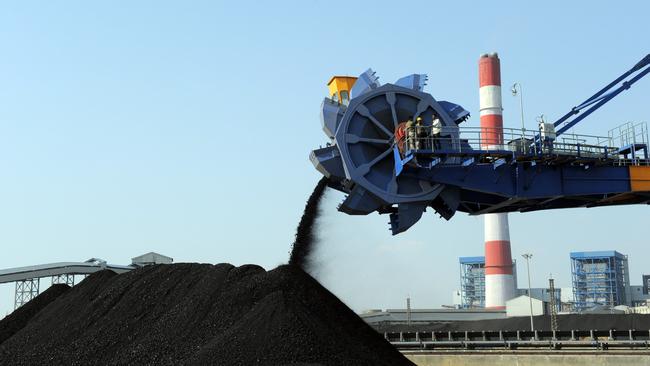China and India behind a likely record for coal demand
Global coal production reached a record in 2023, powered by growth in China, India and Indonesia.

Business
Don't miss out on the headlines from Business. Followed categories will be added to My News.
Global coal demand is forecast to hit a new high in 2024, driven by strong growth from China and India as climate change tsar Matt Kean warned handouts to prolong coal stations in Australia risked creating a “moral hazard”.
The International Energy Agency’s closely watched World Energy Outlook report found global coal production reached a record last year, powered by growth in China, India and Indonesia.
Global coal demand increased by just over 100 million tonnes of coal equivalent in 2023 to about 6000 million tonnes of coal equivalent, mainly because of increased use in the power sector in the Asian nations.
Demand this year is expected to be slightly higher than in 2023, according to the IEA, as strong electricity demand in China and India result in higher coal use, more than offsetting continued cuts in coal use in the EU.
While the IEA expects renewables to lead to less coal use in China, the emergence of India as the world’s second-largest coal consumer and the main driver of future demand growth indicates that a push to phase out the energy source may take longer than official predictions.
The IEA in 2021 declared no new coalmines, oil or gas fields should be opened up if the world is to reach net-zero emissions by 2050. However, the scale of a switch to green energy sources has proved more complex than expected, with developing nations still developing new coal mines as an energy source.
The speed of a transition away from coal remains contentious in Australia amid concern the need to more than double renewable energy supply by 2030 to hit Labor’s target has fallen behind schedule, threatening the stability of the power grid.

Mr Kean weighed into the issue on Wednesday, stating government support to keep ageing coal-fired power stations in NSW such as Origin Energy’s Eraring open could encourage a flurry of handouts to big generators and threaten to delay investment in renewables.
Mr Kean, the former NSW treasurer and energy minister who now heads the Climate Change Authority, said the NSW Labor government’s decision earlier this year to extend the life of Origin’s Eraring power station by at least two years, at a cost of up to $225m a year, could create an unwelcome precedent and a “moral hazard” for taxpayers.
Mr Kean also took a swipe at proposals to build a nuclear power industry, saying it would take too long and was too costly.
“When you extend Eraring without giving certainty to the market, capital will sit on its hands,” Mr Kean told the Citi Australia & New Zealand Investment Conference on Wednesday. “We need to give more certainty to private capital, and that means being very clear with the market around the timings of the exits of plants.”
Mr Kean said governments should always be looking to give the “best deal to taxpayers and consumers”. He said: “We don’t know what taxpayers are going to have to pay for the extension of Eraring and that creates a moral hazard that worries me.
“Does it mean that Energy Australia then comes to the government and says well, we’re going to pull (Mt) Piper (Power Station) out 10 years early, and you need to pay us a huge amount of rent? Does AGL then come to the government and say, well, you paid Origin, we will pull out Bayswater early unless you pay us?”
Mr Kean said he was a big supporter of more market mechanisms and more private capital as Australia moved to net zero. “As I keep saying to my friends who are climate sceptics or are pushing nuclear, you don’t need to believe in climate change to believe in capitalism,” he said.

He said the fact remained that 90 per cent of coal generation was coming out of the system and needed to be replaced quickly. Eraring was fully commissioned in 1984.
“It’s got nothing to do with climate change and everything to do with the fact this is old equipment that was built in the ’70s and ’80s, and it’s at end-of-life,” he said.
Mr Kean said every time Daniel Westerman, the head of the Australian Energy Market Operator, “would flash up on my phone”, as NSW energy minister he knew it was due to supply issues caused by ageing coal-fired power plants.
“It meant that he was warning me that there were shortages in supply, and let me tell you, it wasn’t because there were too many renewables in the system,” Mr Kean said. “It was never the renewables that caused Daniel Westerman to call me and say, minister, we may have to consider load shedding tonight.
“It was the fact that coal was becoming less reliable. A tube leak here, a generator breakdown there. These were more frequent events. We need to replace old technology with newer technology now, and obviously look to the future to see what’s coming on the horizon.”
Mr Kean said that, while it was important to keep an eye on what was happening in the future on nuclear technologies, it would never replace renewables.
“Coal-fired power that has underpinned our economy is coming to the end of its technical life by 2035 so we need to get on with the task of replacing that generation capacity,” Mr Kean said. “The consistent advice of experts, including the CSIRO, is that the most affordable way is to have a system built on renewables, backed by batteries and firming technology. It’s the best way to keep reducing carbon emissions solutions on the road to net zero.”
Mr Kean said nuclear was old technology that had been around since the ’50s and was “not coming down the cost curve”. “Quite frankly, you need to build a lot of redundancy into nuclear to ensure that you maintain the social licence, keep it safe and ensure that it works,” he said.
“So that means the cost of it is incredibly high.”
Originally published as China and India behind a likely record for coal demand



